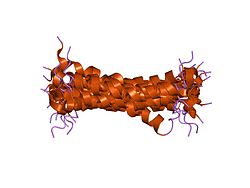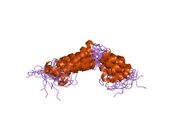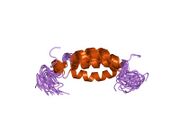Biology:Apolipoprotein C-I
 Generic protein structure example |
| ApoC-I | |||||||||
|---|---|---|---|---|---|---|---|---|---|
 structural studies of a baboon (papio sp.) plasma protein inhibitor of cholesteryl ester transferase. | |||||||||
| Identifiers | |||||||||
| Symbol | ApoC-I | ||||||||
| Pfam | PF04691 | ||||||||
| InterPro | IPR006781 | ||||||||
| SCOP2 | 1ale / SCOPe / SUPFAM | ||||||||
| |||||||||
Apolipoprotein C-I is a protein component of lipoproteins that in humans is encoded by the APOC1 gene.[1][2]
Function
The protein encoded by this gene is a member of the apolipoprotein C family. This gene is expressed primarily in the liver, and it is activated when monocytes differentiate into macrophages. Alternatively spliced transcript variants have been found for this gene, but the biological validity of some variants has not been determined.[3]
Apolipoprotein C-I has a length of 57 amino acids normally found in plasma and responsible for the activation of esterified lecithin cholesterol with an important role in the exchange of esterified cholesterol between lipoproteins and in removal of cholesterol from tissues. Its main function is inhibition of cholesteryl ester transfer protein (CETP), probably by altering the electric charge of HDL molecules.
During fasting (like other apolipoprotein C), it is found primarily within HDL, while after a meal it is found on the surface of other lipoproteins. When proteins rich in triglycerides like chylomicrons and VLDL are broken down, this apoprotein is transferred again to HDL. It is one of the most positively charged proteins in the human body.
Pseudogene
A pseudogene of this gene is located 4 kb downstream from the apoC-I gene in the same orientation on chromosome 19, where both reside within an apolipoprotein gene cluster. This pseudogene, which was also reported to have been present in Denisovans and Neandertals, originated from two separate events. Following the divergence of New World monkeys from the human lineage, the apoC-I gene was duplicated. Old World monkeys and great apes other than humans have been shown to have two active genes. One of the duplicates encodes a basic protein designated apoC-IB that is orthologous to human apolipoprotein C-I. The other encodes an acidic protein, apoC-IA, that is orthologous to the virtual protein encoded by the pseudogene. The pseudogenization event occurred sometime between the divergence of bonobos and chimpanzees from the human lineage and the arrival of Denisovans and Neandertals. The pseudogene is due to a change in a single nucleotide in the codon for the penultimate amino acid, i.e. glutamine, in the signal sequence, resulting in a stop codon.[4][5][6]
Interactive pathway map
References
- ↑ "Isolation and characterisation of a cDNA clone for human apolipoprotein CI and assignment of the gene to chromosome 19". Human Genetics 69 (4): 345–9. 1985. doi:10.1007/BF00291654. PMID 2985493.
- ↑ "Apolipoprotein gene cluster on chromosome 19. Definite localization of the APOC2 gene and the polymorphic Hpa I site associated with type III hyperlipoproteinemia". Human Genetics 78 (1): 90–3. January 1988. doi:10.1007/BF00291243. PMID 2892779.
- ↑ "Entrez Gene: APOC1 apolipoprotein C-I". https://www.ncbi.nlm.nih.gov/sites/entrez?Db=gene&Cmd=ShowDetailView&TermToSearch=341.
- ↑ "Detection of two distinct forms of apoC-I in great apes". Comparative Biochemistry and Physiology. Part D, Genomics & Proteomics 5 (1): 73–9. March 2010. doi:10.1016/j.cbd.2009.12.003. PMID 20209111.
- ↑ "Proteogenomic Review of the Changes in Primate apoC-I during Evolution". Frontiers in Biology 8 (5): 533–548. October 2013. doi:10.1007/s11515-013-1278-7. PMID 28757862.
- ↑ "Higher primates, but not New World monkeys, have a duplicate set of enhancers flanking their apoC-I genes". Comparative Biochemistry and Physiology. Part D, Genomics & Proteomics 11: 45–8. September 2014. doi:10.1016/j.cbd.2014.08.001. PMID 25160599.
Further reading
- "Thf complete amino acid sequence of C-I (apoLp-Ser), an apolipoprotein from human very low density lipoproteins". The Journal of Biological Chemistry 250 (1): 182–90. January 1975. doi:10.1016/S0021-9258(19)41998-4. PMID 166984.
- "Two copies of the human apolipoprotein C-I gene are linked closely to the apolipoprotein E gene". The Journal of Biological Chemistry 263 (15): 7277–86. May 1988. doi:10.1016/S0021-9258(18)68638-7. PMID 2835369.
- "Exact localization of the familial dysbetalipoproteinemia associated HpaI restriction site in the promoter region of the APOC1 gene". Biochemical and Biophysical Research Communications 152 (3): 1282–8. May 1988. doi:10.1016/S0006-291X(88)80424-8. PMID 2897845.
- "There are two gene sequences for human apolipoprotein CI (apo CI) on chromosome 19, one of which is 4 kb from the gene for apo E". Biochemical and Biophysical Research Communications 136 (3): 876–84. May 1986. doi:10.1016/0006-291X(86)90414-6. PMID 3013172.
- "The gene for human apolipoprotein CI is located 4.3 kilobases away from the apolipoprotein E gene on chromosome 19". Human Genetics 73 (4): 286–9. August 1986. doi:10.1007/BF00279087. PMID 3017837.
- "The primary structure of apolopoprotein-serine". The Journal of Biological Chemistry 249 (16): 5308–13. August 1974. doi:10.1016/S0021-9258(19)42365-X. PMID 4369340.
- "Characterisation of mRNAs encoding the precursor for human apolipoprotein CI". Nucleic Acids Research 12 (9): 3909–15. May 1984. doi:10.1093/nar/12.9.3909. PMID 6328444.
- "Evaluation of the mixed interaction between apolipoproteins A-II and C-I equilibrium sedimentation". Biophysical Chemistry 13 (1): 29–38. February 1981. doi:10.1016/0301-4622(81)80022-1. PMID 6789904.
- "Quantitative determination of apolipoproteins C-I and C-II in human plasma by separate electroimmunoassays". Clinical Chemistry 27 (4): 543–8. April 1981. doi:10.1093/clinchem/27.4.543. PMID 7471419.
- "Conformation of two peptides corresponding to human apolipoprotein C-I residues 7-24 and 35-53 in the presence of sodium dodecyl sulfate by CD and NMR spectroscopy". Biochemistry 34 (22): 7401–8. June 1995. doi:10.1021/bi00022a013. PMID 7779782.
- "Oligo-capping: a simple method to replace the cap structure of eukaryotic mRNAs with oligoribonucleotides". Gene 138 (1–2): 171–4. January 1994. doi:10.1016/0378-1119(94)90802-8. PMID 8125298.
- "Fluorescence in situ hybridization mapping of human chromosome 19: cytogenetic band location of 540 cosmids and 70 genes or DNA markers". Genomics 15 (1): 133–45. January 1993. doi:10.1006/geno.1993.1021. PMID 8432525. https://zenodo.org/record/1229582.
- "Genetic association study between senile dementia of Alzheimer's type and APOE/C1/C2 gene cluster". Gerontology 42 Suppl 1: 12–9. 1996. doi:10.1159/000213820. PMID 8804993.
- "Conformational studies of the N-terminal lipid-associating domain of human apolipoprotein C-I by CD and 1H NMR spectroscopy". Protein Science 6 (9): 1858–68. September 1997. doi:10.1002/pro.5560060906. PMID 9300485.
- "Construction and characterization of a full length-enriched and a 5'-end-enriched cDNA library". Gene 200 (1–2): 149–56. October 1997. doi:10.1016/S0378-1119(97)00411-3. PMID 9373149.
- "Patterns of single-nucleotide polymorphisms in candidate genes for blood-pressure homeostasis". Nature Genetics 22 (3): 239–47. July 1999. doi:10.1038/10297. PMID 10391210.
- "Sequencing of 42kb of the APO E-C2 gene cluster reveals a new gene: PEREC1". DNA Sequence 9 (2): 89–100. 1999. doi:10.3109/10425179809086433. PMID 10520737.
- "Human apolipoprotein C-I accounts for the ability of plasma high density lipoproteins to inhibit the cholesteryl ester transfer protein activity". The Journal of Biological Chemistry 275 (48): 37504–9. December 2000. doi:10.1074/jbc.M007210200. PMID 10978346.
- "DNA cloning using in vitro site-specific recombination". Genome Research 10 (11): 1788–95. November 2000. doi:10.1101/gr.143000. PMID 11076863.
External links
- Human APOC1 genome location and APOC1 gene details page in the UCSC Genome Browser.
- PDBe-KB provides an overview of all the structure information available in the PDB for Human Apolipoprotein C-I



